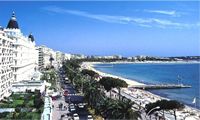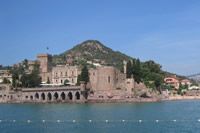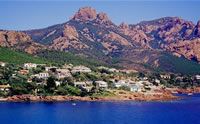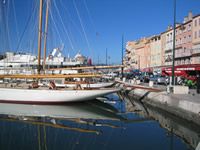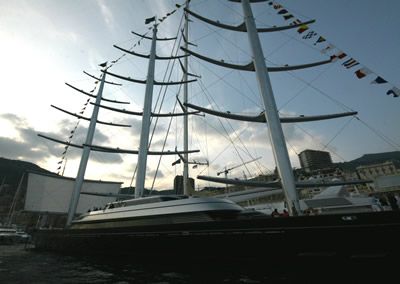Over the Barrel –
The most common method of punishment aboard ship was flogging. The
unfortunate sailor was tied to a grating, mast or over the barrel of a deck
cannon.
To Know the Ropes –
There was miles and miles of cordage in the rigging of a square rigged
ship. The only way of keeping track of and knowing the function of all of
these lines was to know where they were located. It took an
experienced seaman to know the ropes.
Dressing Down –
Thin and worn sails were often treated with oil or wax to renew their
effectiveness. This was called “dressing down”. An officer or sailor who
was reprimanded or scolded received a dressing down.
Footloose –
The bottom portion of a sail is called the foot. If it is not secured, it is
footloose and it dances randomly in the wind.
Booby Hatch –
Aboard ship, a booby hatch is a sliding cover or hatch that must be
pushed away to allow access or passage.
First Rate –
Implies excellence. From the 16th century on until steam powered ships
took over, British naval ships were rated as to the number of heavy
cannon they carried. A ship of 100 or more guns was a First Rate
line-of-battle ship. Second rates carried 90 to 98 guns; Third Rates, 64 to
89 guns; Fourth Rates, 50 to 60 guns. Frigates carrying 20 to 48 guns were
fifth and sixth rated.
Pipe Down –
Means stop talking and be quiet. The Pipe Down was the last signal from
the Boson’s pipe each day which meant “lights out” and “silence”.
Chock-a-block –
Meaning something is filled to capacity or over loaded. If two blocks of
rigging tackle were so hard together they couldn’t be tightened further,
it was said they were “Chock-a-Block”.
Leeway –
The weather side of a ship is the side from which the wind is blowing.
The Lee side is the side of the ship sheltered from the wind. A lee shore
is a shore that is downwind of a ship. If a ship does not have enough
“leeway” it is in danger of being driven onto the shore.
Windfall –
A sudden unexpected rush of wind from a mountainous shore which
allowed a ship more leeway.
Groggy –
In 1740, British Admiral Vernon (whose nickname was “Old Grogram” for
the cloak of Grogram which he wore) ordered that the sailors’ daily ration
of rum be diluted with water. The men called the mixture “grog”. A sailor
who drank too much grog was “groggy”.
Three Sheets to the Wind –
A sheet is a rope line which controls the tension on the downwind side
of a square sail. If, on a three Amsted fully rigged ship, the sheets of the
three lower course sails are loose, the sails will flap and flutter and are
said to be “in the wind”. A ship in this condition would stagger and
wander aimlessly downwind.
Pooped –
The poop is the stern section of a ship. To be pooped is to be swamped
by a high, following sea.
As the Crow Flies –
When lost or unsure of their position in coastal waters, ships would
release a caged crow. The crow would fly straight towards the nearest
land thus giving the vessel some sort of a navigational fix. The tallest
lookout platform on a ship came to be know as the crow’s nest.
Buoyed Up –
Using a buoy to raise the bight of an anchor cable to prevent it from
chafing on a rough bottom.
By and Large –
Currently means in all cases or in any case. From the nautical: by meaning
into the wind and large meaning with the wind: as in, “By and Large the
ship handled very well.”
Cut and Run –
If a captain of a smaller ship encountered a larger enemy vessel, he might
decide that discretion is the better part of valor, and so he would order
the crew to cut the lashings on all the sails and run away before the
wind. Other sources indicate “Cut and Run” meant to cut the anchor
cable and sail off in a hurry.
In the Offing –
Currently means something is about to happen, as in – “There is a
reorganization in the offing.” From the 16th century usage meaning a
good distance from shore, barely visible from land, as in – “We sighted a
ship in the offing.”
Skyscraper –
A small triangular sail set above the skysail in order to maximize effect in
a light wind.
The Bitter End –
The end of an anchor cable is fastened to the bits at the ship’s bow. If
all of the anchor cable has been paid out you have come to the bitter
end.
Toe the Line –
When called to line up at attention, the ship’s crew would form up with
their toes touching a seam in the deck planking.
Back and Fill –
A technique of tacking when the tide is with the ship but the wind is
against it.
Overhaul –
To prevent the buntline ropes from chaffing the sails, crew were sent
aloft to haul them over the sails. This was called overhauling.
Slush Fund –
A slushy slurry of fat was obtained by boiling or scraping the empty salted
meat storage barrels. This stuff called “slush” was often sold ashore by
the ship’s cook for the benefit of himself or the crew. The money so
derived became known as a slush fund.
Bear Down –
To sail downwind rapidly towards another ship or landmark.
Under the Weather –
If a crewman is standing watch on the weather side of the bow, he will
be subject to the constant beating of the sea and the ocean spray. He
will be under the weather.
Overreach –
If a ship holds a tack course too long, it has overreached its turning point
and the distance it must travel to reach it’s next tack point is increased.
Gone By the Board –
Anything seen to have gone overboard or spotted floating past the ship
(by the board) was considered lost at sea.
Above Board –
Anything on or above the open deck. If something is open and in plain
view, it is above board.
Overwhelm –
Old English for capsize or founder.
Between the Devil and the Deep Blue Sea –
The devil seam was the curved seam in the deck planking closest to the
side of the ship and next to the scupper gutters. If a sailor slipped on
the deck, he could find himself between the devil and the deep blue
sea.
The Devil to Pay –
To pay the deck seams meant to seal them with tar. The devil seam was
the most difficult to pay because it was curved and intersected with the
straight deck planking. Some sources define the “devil” as the
below-the-waterline-seam between the keel and the the adjoining
planking. Paying the Devil was considered to be a most difficult and
unpleasant task.
Rummage Sale –
From the French “arrimage” meaning ship’s cargo. Damaged cargo was
sold at a rummage sale.
A Square Meal –
In good weather, crews’ mess was a warm meal served on square wooden
platters.
Son of a Gun –
When in port, and with the crew restricted to the ship for any extended
period of time, wives and ladies of easy virtue often were allowed to live
aboard along with the crew. Infrequently, but not uncommonly, children were
born aboard, and a convenient place for this was between guns on the gun
deck. If the child’s father was unknown, they were entered in the ship’s log as
“son of a gun”.
Overbearing –
To sail downwind directly at another ship thus “stealing” or diverting the wind
from his sails.
Taking the wind out of his sails –
Sailing in a manner so as to steal or divert wind from another ship’s sails.
Let the Cat Out of the Bag –
In the Royal Navy the punishment prescribed for most serious crimes was
flogging. This was administered by the Boson’s Mate using a whip called a cat
o’ nine tails. The “cat” was kept in a leather or baize bag. It was considered
bad news indeed when the cat was let out of the bag. Other sources
attribute the expression to the old English market scam of selling someone a
pig in a poke (bag) when the pig turned out to be a cat instead.
No Room to Swing a Cat –
The entire ship’s company was required to witness flogging at close hand. The
crew might crowd around so that the Boson’s Mate might not have enough
room to swing his cat o’ nine tails.
Start Over with a Clean Slate –
A slate tablet was kept near the helm on which the watch keeper would
record the speeds, distances, headings and tacks during the watch. If there
were no problems during the watch, the slate would be wiped clean so that
the new watch could start over with a clean slate.
Taken Aback –
A dangerous situation where the wind is on the wrong side of the sails
pressing them back against the mast and forcing the ship astern. Most often
this was caused by an inattentive helmsman who had allowed the ship to head
up into the wind.
At Loggerheads –
An iron ball attached to a long handle was a loggerhead. When heated it
was used to seal the pitch in deck seams. It was sometimes a handy weapon
for quarreling crewmen.
Fly-by-Night –
A large sail used only for sailing downwind and requiring rather little attention.
No Great Shakes –
When casks became empty they were “shaken” (taken apart) so the pieces,
called shakes, could be stored in a small space. Shakes had very little value.
Give (someone) a Wide Berth –
To anchor a ship far enough away from another ship so that they did not hit
each other when they swung with the wind or tide.
Cut of His Jib –
Warships many times had their foresails or jib sails cut thinly so that they
could maintain point and not be blown off course. Upon sighting thin foresails
on a distant ship a captain might not like the cut of his jib and would then
have an opportunity to escape.
Garbling was the prohibited practice of mixing rubbish with the cargo. A
distorted, mixed up message was said to be garbled.The British navy filled their ships’ crew quotas by kidnapping men off the
streets and forcing them into service. This was called Impressments and was
done by Press Gangs.
Touch and Go –
This referred to a ship’s keel touching the bottom and getting right off again.
Scuttlebutt –
A butt was a barrel. Scuttle meant to chop a hole in something. The
scuttlebutt was a water barrel with a hole cut into it so that sailors could
reach in and dip out drinking water. The scuttlebutt was the place where the
ship’s gossip was exchanged.
Thanks to the people at www.iokbadcredit.com for this!
